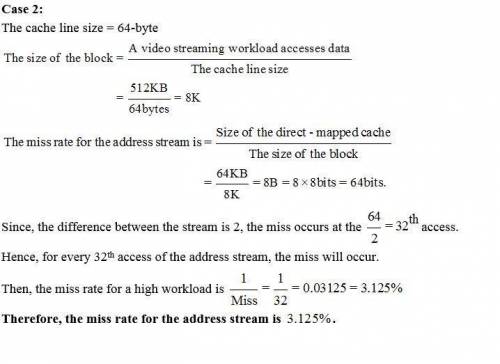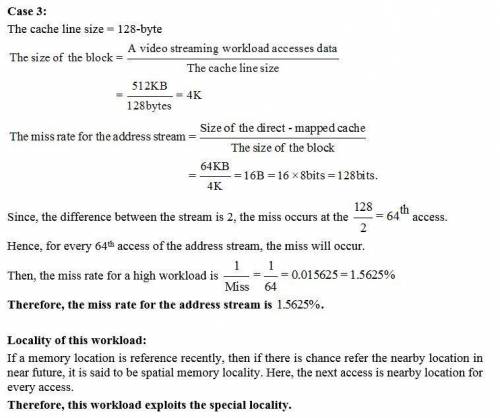
Computers and Technology, 08.11.2019 06:31 janeou17xn
Media applications that play audio or video files are part of a class of workkloads called "streaming" workloads (i. e., they bring in large amounts of data but do not reuse much of it). consider a video streaming workload that accesses a 512 kib working set sequentially with the following word address stream:
0, 1, 2, 3, 4, 5, 6, 7, 8, 9
a) assume a 64 kib direct-mapped cache with a 32-byte block. what is the miss rate for the address stream above? how is this miss rate sensitive to the size of the cache or the working set? how would you categorize the misses this workload is experiencing, based on the 3c model?
b) re-compute the miss rate when the cache block size is 16 bytes, 64 bytes, and 128 bytes. what kind of locality is this workoad exploiting?
c) "prefetching" is a technique that leverages predictable address patterns to speculatively bring in additoinal cache blocks when a particular cache block is accessed. one example of prefetching is a stream buffer that prefetches sequentially adjacent cache blocks into a separate buffer when a particular cache block is brought in. if the data are found in the prefetch buffer, it is considered as a hit, moved into the cache, and the cache block is prefetched. assume a two-entry stream buffer; and, assume that the cache latency is such that a cache block can be loaded before the computation of the previous cache block is completed. what is the miss rate for the address stream above?

Answers: 1


Another question on Computers and Technology

Computers and Technology, 22.06.2019 16:10
Drag each label to the correct location on the imagelist the do’s and don’ts of safeguarding your password.keep yourself loggedin when you leave your computer.don’t write your password down and leave it whereothers can find it.share your password with your friends.each time you visit a website,retain the cookies on your computer.use a long password with mixed characters.
Answers: 1

Computers and Technology, 22.06.2019 21:00
Simon says is a memory game where "simon" outputs a sequence of 10 characters (r, g, b, y) and the user must repeat the sequence. create a for loop that compares the two strings starting from index 0. for each match, add one point to userscore. upon a mismatch, exit the loop using a break statement. assume simonpattern and userpattern are always the same length. ex: the following patterns yield a userscore of 4: simonpattern: rrgbryybgy userpattern: rrgbbrybgy
Answers: 2

Computers and Technology, 25.06.2019 04:10
This might be a bit off-topic, but i'm having trouble with a certain arg made by game theory. if there are any theorists out there that wanna , it would be appreciated!
Answers: 2

Computers and Technology, 25.06.2019 05:10
Assume that two parallel arrays have been declared and initialized: healthoption an array of type char that contains letter codes for different healthcare options and annual cost an array of type int. the i-th element of annual cost indicates the annual cost of the i-th element of healthoption. in addition, there is an char variable, best2.write the code necessary to assign to best2 the health option with the lower annual cost, considering only the first two healthcare options. thus, if the values of healthoption are 'b', 'q', 'w', 'z' and the values of annualcost are 8430, 9400, 7050, 6400 your code would assign 'b' to best2 because 8430 is less than 9400 and is associated with 'b' in the parallel array. (we ignore 'w' and 'z' because we are considering only the first two options.)
Answers: 1
You know the right answer?
Media applications that play audio or video files are part of a class of workkloads called "streamin...
Questions

Advanced Placement (AP), 09.12.2019 05:31





English, 09.12.2019 05:31

Mathematics, 09.12.2019 05:31


Mathematics, 09.12.2019 05:31

History, 09.12.2019 05:31




Mathematics, 09.12.2019 05:31




Social Studies, 09.12.2019 05:31

Mathematics, 09.12.2019 05:31








